![]()
![]()
![]()
Use LEFT and RIGHT arrow keys to navigate between flashcards;
Use UP and DOWN arrow keys to flip the card;
H to show hint;
A reads text to speech;
31 Cards in this Set
- Front
- Back

|
Les Tres Riches Heures du Duc de Berry Chantilly, 1400 - book of hours; prayer calendar - expensive: made for wealthy landowners - depicted scenes from daily life: entertainment - scenes pandered to views of upper class |
|
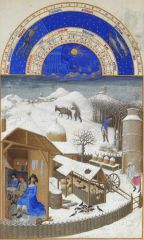
|
February Chantilly, 1400 - appeals to audience: both sheep and laborers smile and behave nicely and as expected |
|
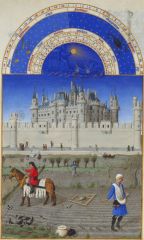
|
October Chantilly, 1400 - peasants are emotionless/quiet; features of the landscape - looming castle/its distance from peasant suggests class divide - details allow for intimate inspection |
|
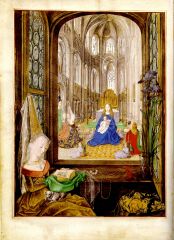
|
Hours of Mary of Burgundy Vienna, 1500 - Mary; swathed in fabric, holds a book of hours, wealthy - vision of Virgin; through images, heaven can be reached - (superfluous) detail over clarity; entertains (we do not observe same level of detail in reality) - inception of figures; Mary views herself in the painting, who again sees herself through the window - church of heaven; tangible, resembles common church plan |
|

|
Jan van Eyck, The Annunciation Netherlands, (Washington DC) 1450 - bountiful detail: facilitated by oil painting - dove; enters through ray of light to Virgin's ear, suggesting the 'word of God' - floor; engraved with narratives from old testament |
|
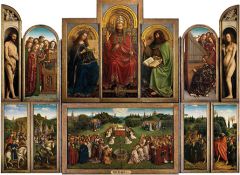
|
Ghent Altarpiece, Ghent, 1450 - polyptych; many panels - illusionistic: in paintings of saint, painting resembling sculpture - 'sculptures' are monochromatic, same color as tracery - inside: sacrificial lamb, fountain of life in the shape of octagonal baptistery - Adam and Eve: shamed and naked; contrasts with surrounding robed figures - God the Father: triple crown (like Pope) |
|
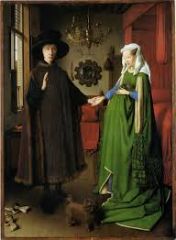
|
Arnolfini Wedding London, 1450 - depicts wedding contract - same quality of extraneous detail: adds to legitimacy of scene - single lit candle represents the presence of Christ - mirror in back; allows us to see entire room - represents 'all seeing eye of God' - contract made under the approval of Christ - yet, in the mirror: Jan van Eyck is visible: suggests that van Eyck is the creator (Godlike) |
|
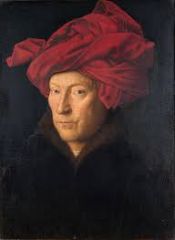
|
Man in a Red Turban London 1450 - details are unflattering, yet, in the details of his painting, we can observe his skill |
|
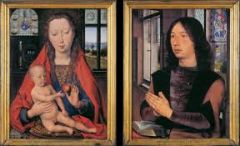
|
Diptych of Martin van Nieuwenhove Bruges, 1500 - mirror allows us to see backs of Virgin and Martin van Nieuwenhove; unity between the two panels - Virgin visits Martin in his own hometown - open prayer book suggest Virgin is a vision |
|
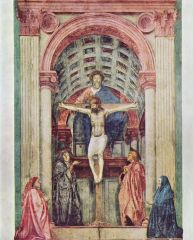
|
Masaccio, Trinity Florence 1400 - depicts the Holy Trinity - linear perspective - portrays God in a man-made space |
|

|
Fabriano, Adoration of the Magi Florence, 1400 - surface over depth/linear perspective - depicts people on a journey to see Christ - not a single plane: line winds around top of pc. - slightly blurry: emphasizes gold print |
|
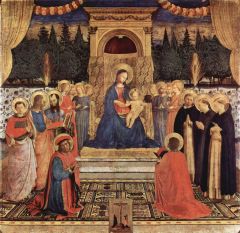
|
San Marco Altarpiece Florence 1450 - linear perspective; - foreground: icon painting, not linear persp. - icon image conjurs scene behind it - through prayer; see virgin |
|
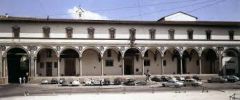
|
Ospedale degli Innocenti Florence 1400 - orphanage; paid for by silk/goldsmith guildsu - mathematical proportions - harmony created through regularity - draws from Roman classical forms |
|

|
da Vinci, The Last Supper Milan, 1500 - Christ in center: four groups of three - unified through gestures and height of figures - depth: space recedes behind Christ - Christ framed by central window: resembles icon painting |
|
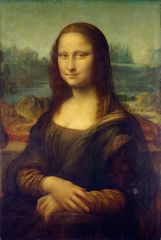
|
da Vinci, Mona Lisa Paris 1500 - no line; instead sfumato - chiaroscuro; light/dark - areas of light and dark block information (lines) from the observer for |
|
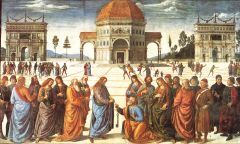
|
Perugino, Christ Delivering the Keys of Heaven to Saint Peter Vatican 1500 - Saint Peter: first Pope - vanishing point: central plan Church, site of Papal conclave |
|

|
Creation of Adam Vatican 1500 - distinct lines - story created through gestures of figures - God; bent knee = movement: active, a giver - Adam; receiver; muscles: potential action |
|

|
Libyan Sibyl Vatican 1500 - contorted body - heavy book rests on toes: strain - suggest Michelangelo's play with body/form |
|
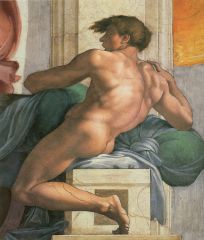
|
Ignudi Vatican 1500 - Portrayed in many different poses - Michelangelo experiments with form of figures |
|
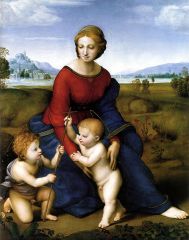
|
Madonna of the Meadow Vienna 1500 - soft shadow - no extremes (muscles, shadow) |
|

|
School of Athens Vatican, 1500 - painted for Papal palace - shows philosophers from different eras - painted mosaic, not gold mosaic; talent/skill valued over expensive materials - linear perspective - well lit space |
|
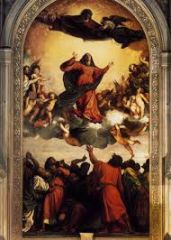
|
Assumption of the Virgin Venice 1500 - Virgin actively moving into heaven - compositionally connected: pouti form circle around Virgin, outstretched arms point to Virgin |
|

|
Christ in the House of Levi Venice 1600 - originally titled "Last Supper" - asked to change it: 'extraneous' detail - only changed name |
|
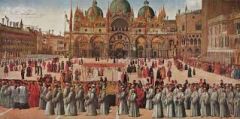
|
Procession in the Piazza San Marco Venice, 1500 - campanile moved for visual clarity - procession places confraternity (patrons) at front (rather than doge at side); viewpoint emphasizes important figures - miracle of true cross; depicted in foreground - city emphasized; connects miracle to city |
|
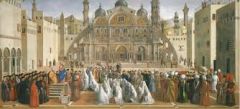
|
Saint Mark Preaching in Alexandria Milan, 1500 - building in back resembles Basilica San Marco - painting resembles procession painting - anachronistic: shows 16th c. Venetians, and Ottomans in a 1st century space - by giving Venice presence in past; relinquishes the fact that St. Mark never went to Venice, remedies xenophobia, connects patron saint to Venice, allows Venetians to be present in the past |
|
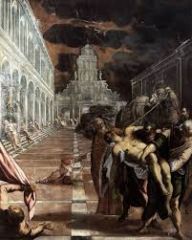
|
Tintoretto, Stealing of the Body Venice 1550 - supernatural, violent storm - not 9th century furta sacra, but 1st century saving of the body from cremation - buildings resembles piazza San Marco - Venetian identity tied to architecture |
|
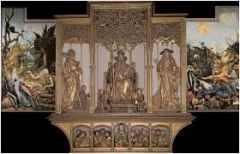
|
Isenheim Altarpiece Isenheim, Germany, 1500 - made for Monastery of Saint Anthony, whose monks cared for the diseased - outside; Crucifixion - Christ's body is contorted/repulsive; speaks specifically to the afflicted people of the monastery; Christ understands their pain - inside; shows Christ resurrected; no wounds, has triumphed over pain and the mortal body - suggests redemption, promise of relief |
|

|
The Wedding Dance Detroit, 1550 - captures scene in the moment - unlike book of hours for Duc de Berry, does not put down peasants; instead, they seem happy - intended for city dwelling middle class; reminiscent of the joys of farm life - does not moralize; peasants behave appropriately |
|
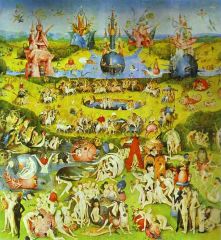
|
Garden of Earthly Delights Madrid, 1500 - triptych - left panel: God with Adam and Eve in the Garden of Eden; peaceful - center panel; scenes of wild pleasure; sexual references - right panel; distopian - outside shows flooded spherical world; reference to Great Flood - overall: warning against the pitfalls of indulging in excessive pleasures |
|
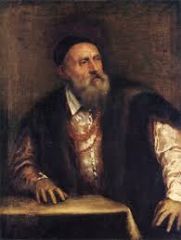
|
Titian, Self Portrait Berlin 1550 - self portraits: portray working self, or self at ease/ presentable |
|
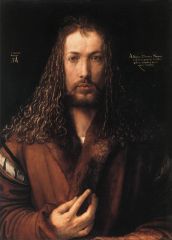
|
Durer, Self Portrait Munich, 1500 - no sign of him as a working artis - strikes pose that resembles portrayals of Christ - suggests that painter = creator = Godly - Christ as Pantokrator, Christ as Savior of Souls |

